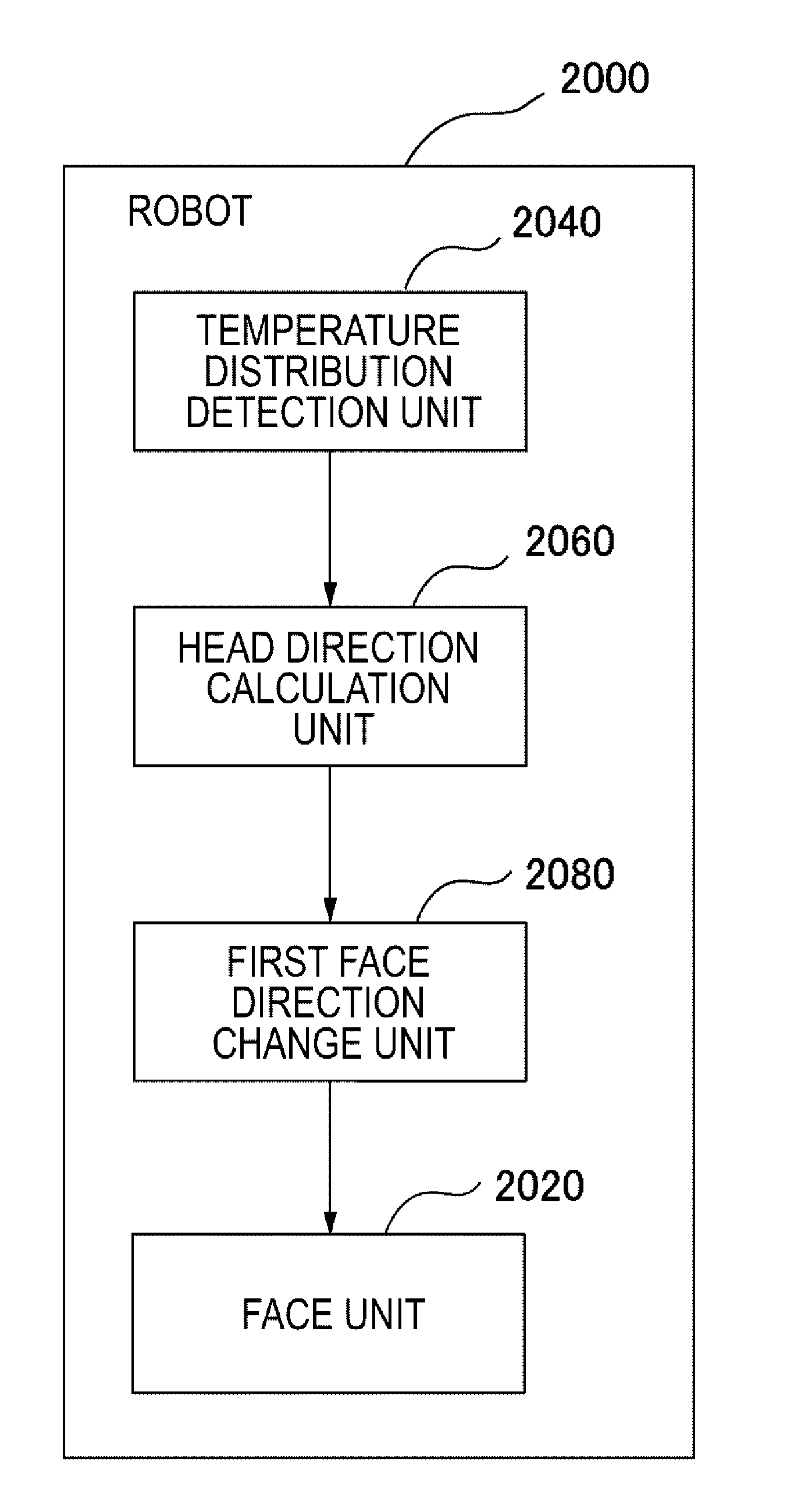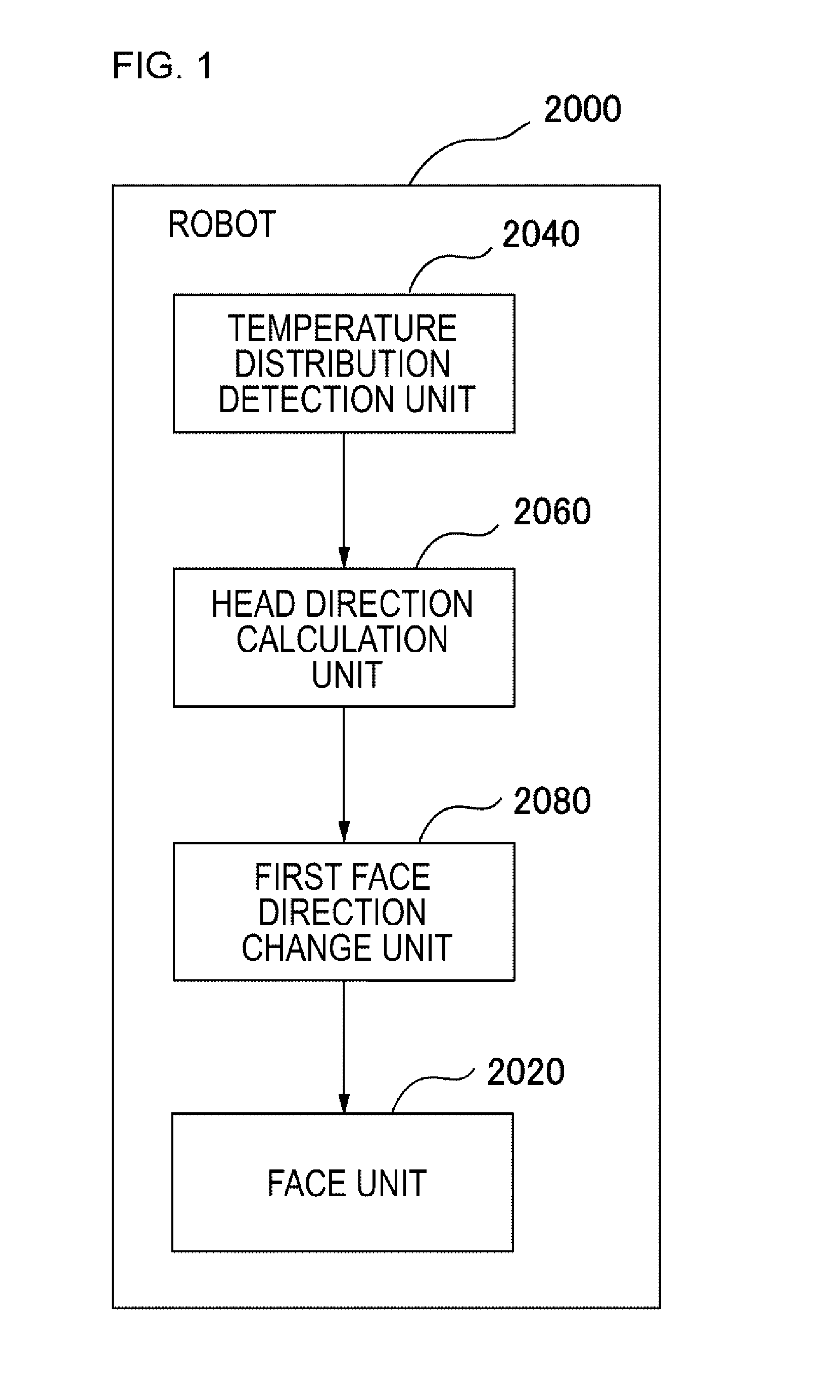Robot, control method, and program
a control method and robot technology, applied in the field of robots and control methods, can solve the problems of hard robots to detect the face of people from the image of the surroundings, and wrongly detecting the face in the picture as the face of real people, so as to increase the probability, increase the probability, and increase the probability of a person's head
- Summary
- Abstract
- Description
- Claims
- Application Information
AI Technical Summary
Benefits of technology
Problems solved by technology
Method used
Image
Examples
exemplary embodiment 1
[0040]FIG. 1 is a block diagram illustrating a robot 2000 arrow indicates a flow of information. In addition, in FIG. 1, each block indicates not a configuration in the hardware unit but a configuration in the function unit.
[0041]
[0042]The robot 2000 includes a face unit 2020, a temperature distribution detection unit 2040, a head direction calculation unit 2060, and a first face direction change unit 2080. The temperature distribution detection unit 2040 includes a plurality of photo-detectors, which are disposed in a grid form. The temperature distribution detection unit 2040 detects a temperature distribution of a detection region by using the plurality of photo-detectors. The head direction calculation unit 2060 calculates a direction in which a person's head is located based on the temperature distribution detected by the temperature distribution detection unit 2040. The first face direction change unit 2080 directs the face unit 2020 in the direction calculated by the head dir...
exemplary embodiment 2
[0080]FIG. 6 is a block diagram illustrating a head direction calculation unit 2060 of a robot 2000 according to Exemplary embodiment 2. The robot 2000 according to the Exemplary embodiment 2 is the same as the robot 2000 according to the Exemplary embodiment 1 except that the head direction calculation unit 2060 includes respective functional constituent units illustrated in FIG. 6. In FIG. 6, an arrow indicates a flow of information. In addition, in FIG. 6, each block indicates not a configuration in the hardware unit but a configuration in the function unit.
[0081]The head direction calculation unit 2060 according to Exemplary embodiment 2 includes a reference temperature distribution storage unit 2061, a candidate position determination unit 2062, a head position determination unit 2063, and a direction calculation unit 2064.
[0082]2061>
[0083]The reference temperature distribution storage unit 2061 stores a reference temperature distribution. For example, the robot 2000 includes a...
exemplary embodiment 3
[0096]FIG. 8 is a block diagram illustrating a head direction calculation unit 2060 of a robot 2000 according to Exemplary embodiment 3. The robot 2000 according to the Exemplary embodiment 3 is the same as the robot 2000 according to the Exemplary embodiment 2 except that the head direction calculation unit 2060 includes respective functional constituent units illustrated in FIG. 8. In FIG. 8, an arrow indicates a flow of information. In addition, in FIG. 8, each block indicates not a configuration in the hardware unit but a configuration in the function unit.
[0097]The head direction calculation unit 2060 of Exemplary embodiment 3 has a function of updating the reference temperature distribution stored in the reference temperature distribution storage unit 2061. For this, the head direction calculation unit 2060 of Exemplary embodiment 3 includes a reference temperature distribution update unit 2065. Here, the temperature distribution detection unit 2040 of Exemplary embodiment 3 r...
PUM
 Login to View More
Login to View More Abstract
Description
Claims
Application Information
 Login to View More
Login to View More - R&D
- Intellectual Property
- Life Sciences
- Materials
- Tech Scout
- Unparalleled Data Quality
- Higher Quality Content
- 60% Fewer Hallucinations
Browse by: Latest US Patents, China's latest patents, Technical Efficacy Thesaurus, Application Domain, Technology Topic, Popular Technical Reports.
© 2025 PatSnap. All rights reserved.Legal|Privacy policy|Modern Slavery Act Transparency Statement|Sitemap|About US| Contact US: help@patsnap.com



